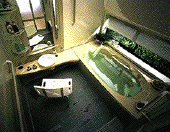 Science & Technology || Search|| Back Numbers BUILDING FOR THE GOLDEN YEARS: Elderly-Friendly Housing Opens the Door to a Better Life February 16, 1998 
Safe, user-friendly bathrooms are a fixture in more new houses. (Photo: Sekisui Chemical Industry Co.) As Japan proceeds rapidly toward an aged society, housing designed especially to provide greater safety and comfort for the elderly and physically disabled, with no steps at the entrance and handrails on the stairs and in the bathtub, is becoming more and more common. The Ministry of Construction has formulated guidelines for the building of these elderly-friendly homes, and the government has adopted measures for the promotion of housing that follows them, including extra loans and preferential interest rates. The building of houses for a comfortable life in old age is attracting widespread attention. Respecting Independence, Preventing Accidents Take the case of a man in his seventies living in Tokyo who recently rebuilt his home so that he and his wife could live together with his son and daughter-in-law. First of all, he designed the hallways with a width of more than one meter so that in the future they would allow free movement in a wheelchair. Then he made sure that the stairs had a gentle incline and that each step had double the usual width. He also installed handrails on the stairs, in the hallways, and in the bathroom and toilet. Furthermore, he planned the layout of the house so that the elderly and younger couples could live separately on the first and second floors, respectively, though with a common living room on the first floor where they could all get together. As a result of the house's design, the man reports, there has been an increase in intergenerational interaction as the two couples help one another with the household chores and enjoy chatting. One of the most important factors in the design of comfortable housing for the elderly and physically disabled is the proper consideration of safety. When building new homes or renovating existing ones, an increasing number of families now pay consideration to this aspect and take the opportunity to incorporate such conveniences as handrails and slip-prevention mats in the bathtub and on the stairs. In the case of two- or three-generation households, these measures to prevent accidents are essential. But there is also an emphasis on layout designed to maintain the feeling of independence and activity of elderly people. For example, space is ensured for them to enjoy hobbies or to move easily to and from the living room or garden. To respond to these needs, housing-related companies are beginning to
make various efforts to promote housing construction for elderly people.
For example, one leading home builder's research institute on special
housing for the elderly conducted a questionnaire survey of 868 persons
aged 65 or over who visited the company's housing exhibit site or purchased
a home. The aim of the questionnaire was to investigate the relationship
between old people's zest for life and their housing. The results of the
survey, which were released in September 1997, showed that between 20% and
40% of respondents who required some kind of care in their lives cited "no
emergency alarm," "cannot use a wheelchair," and "difficult to use the
bathroom" as reasons for their concern about housing. These figures were
all 10 or more percentage points higher than for healthy persons.
At the same time, while 64% of respondents who replied that they were extremely satisfied with their housing reported that their mental health condition was good, conversely only 28% of respondents who were dissatisfied with their housing reported a good mental health condition and 31% even reported a bad mental health condition, which suggests an even closer correlation than expected by the research group between mental health and the degree of satisfaction with housing. The institute has stressed the need for housing construction that goes as far as considering the mental health of elderly people. Convenient Housing for a Better Aged Society Against the background of this change in the household structure and
increasing interest in the role that housing plays in realizing a
fulfilling life, the Ministry of Construction in 1995 compiled guidelines
for the building of housing for elderly people. The guidelines encourage
barrier-free design so that elderly and physically disabled persons can
live comfortably and provide for an extra loan of 1.5 million yen (12,000
U.S. dollars at 125 yen to the dollar) from the governmental Housing Loan
Corporation for new construction or rebuilding of housing that fulfills
certain conditions. An extra 3 million yen (2400 dollars) is added to
the loan if the household has a member aged 60 or over. And preferential
interest rates are available if the construction or remodeling conforms to
certain barrier-free building standards.
 Edited by Japan Echo Inc. based on domestic
Japanese news sources. Articles presented here are offered for reference
purposes and do not necessarily represent the policy or views of the Japanese
Government. Edited by Japan Echo Inc. based on domestic
Japanese news sources. Articles presented here are offered for reference
purposes and do not necessarily represent the policy or views of the Japanese
Government.
|
